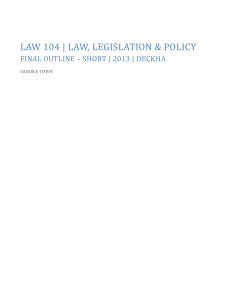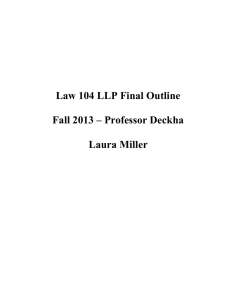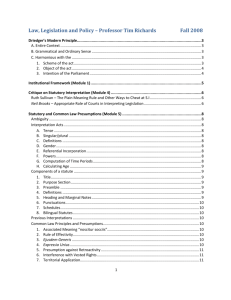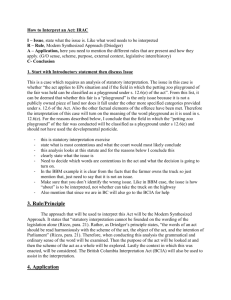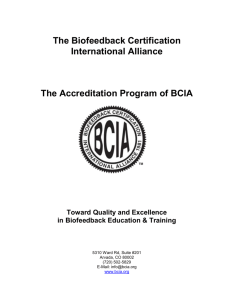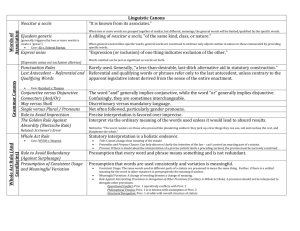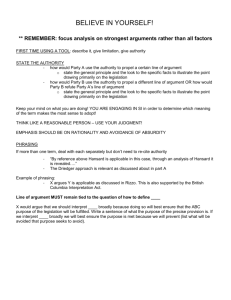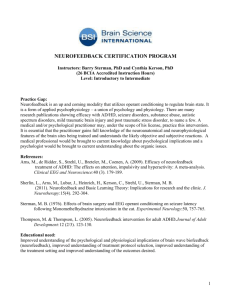Common Law Principles and Presumptions
advertisement
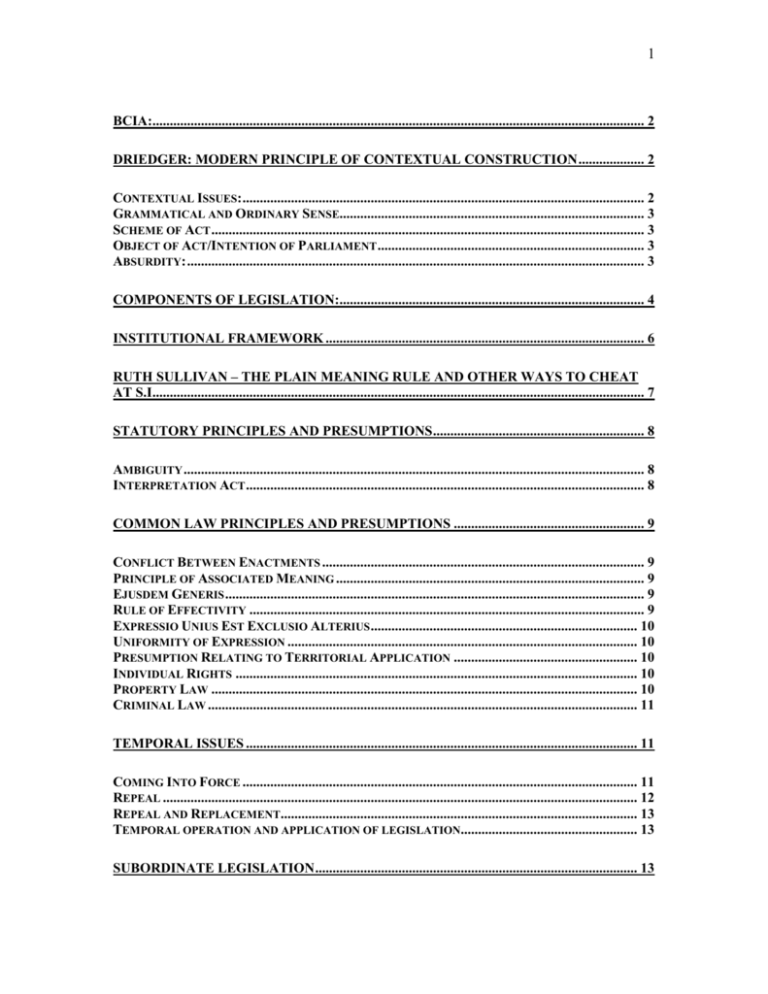
1 BCIA:.............................................................................................................................................. 2 DRIEDGER: MODERN PRINCIPLE OF CONTEXTUAL CONSTRUCTION ................... 2 CONTEXTUAL ISSUES: .................................................................................................................... 2 GRAMMATICAL AND ORDINARY SENSE........................................................................................ 3 SCHEME OF ACT ............................................................................................................................. 3 OBJECT OF ACT/INTENTION OF PARLIAMENT ............................................................................. 3 ABSURDITY: .................................................................................................................................... 3 COMPONENTS OF LEGISLATION:........................................................................................ 4 INSTITUTIONAL FRAMEWORK ............................................................................................ 6 RUTH SULLIVAN – THE PLAIN MEANING RULE AND OTHER WAYS TO CHEAT AT S.I.............................................................................................................................................. 7 STATUTORY PRINCIPLES AND PRESUMPTIONS ............................................................. 8 AMBIGUITY ..................................................................................................................................... 8 INTERPRETATION ACT ................................................................................................................... 8 COMMON LAW PRINCIPLES AND PRESUMPTIONS ....................................................... 9 CONFLICT BETWEEN ENACTMENTS ............................................................................................. 9 PRINCIPLE OF ASSOCIATED MEANING ......................................................................................... 9 EJUSDEM GENERIS ......................................................................................................................... 9 RULE OF EFFECTIVITY .................................................................................................................. 9 EXPRESSIO UNIUS EST EXCLUSIO ALTERIUS ............................................................................. 10 UNIFORMITY OF EXPRESSION ..................................................................................................... 10 PRESUMPTION RELATING TO TERRITORIAL APPLICATION ..................................................... 10 INDIVIDUAL RIGHTS .................................................................................................................... 10 PROPERTY LAW ........................................................................................................................... 10 CRIMINAL LAW ............................................................................................................................ 11 TEMPORAL ISSUES ................................................................................................................. 11 COMING INTO FORCE .................................................................................................................. 11 REPEAL ......................................................................................................................................... 12 REPEAL AND REPLACEMENT....................................................................................................... 13 TEMPORAL OPERATION AND APPLICATION OF LEGISLATION................................................... 13 SUBORDINATE LEGISLATION ............................................................................................. 13 2 BCIA: s. 8: Legislation “must be construed as being remedial, and must be given such fair, large and liberal construction and interpretation as best ensures the attainment of its objects” -Expansive rather than technical (see Rizzo: protect vulnerable group) -Informed by legislative purpose; strongest for benefit-conferring legisl. s. 2(1): BCIA applies unless there is a clear intention to the contrary Driedger: modern principle of contextual construction “The words of an Act are to be read in their entire context and in their grammatical and ordinary sense harmoniously with the scheme of the Act, the object of the Act, and the intention of Parliament.” Contextual Issues: Economic & social realities (Canada 3000) Other statutes, reg. schemes (Canada 3000) o Horizontal coherence o Legislature speaks w/ a single voice o Presumption: legislation coheres w/ other leg. from same legislature (i.e. in terms of word/phrase meanings) o Internal coherence o An act must be coherent within itself o Columbia River o Presumption of “harmony, coherence and consistency” with other statutes dealing w/ same subject matter (Ulybel) o Vertical coherence o Constitution trumps everything o Subordinate legislation must be consistent w/ enabling statute o Federal over provincial legislation o Human rights over general legislation o Sharpe where ambiguity arises, interpret to agree w/ constitution o Bell ExpressVu Area-specific legal principles (Merk – “up the ladder”; Sharpe – child pornography) Entire act: purpose, object See Components of a Specific section Statute Policy considerations Legiszlative history o Transitional (Merk, Rizzo) Changes to wording o Re SFU and District of Burnaby change in wording changed meaning in law (legislative intent) o BCIA s. 37(2) change in wording doesn’t presumptively = change in meaning of law Possible reference documents in order of weight (Firearms Reference): o Briefing notes (strongest) 3 o o o o Alternative draft versions of bill House committee reports Hansard (Sharpe) frail evidence (Rizzo, Merk) Press releases (weakest) Grammatical and Ordinary Sense Words in legislation are presumed to be used in their usual or ordinary sense, absent clear intention to the contrary o Ontario Mushroom; Shaklee – “meal test” for definition of food Plain meaning approach (McIntosh majority) a secondary principle o “Where the language of the statute is plain and admits of only one meaning, the task of interpretation does not arise.” o “As a general rule, interpretation should not add to the terms of the law” But plain meaning won’t always be the sensible interpretation o Particularly when the legislation is intended for a specific group, not the average person (Canada 3000, Shaklee) Dictionaries use with caution (McIntosh dissent, Shaklee, Riddell) o Useful in Committee for the Commonwealth of Canada Bilingual versions (Canada 3000, Medovarski) o Side with narrower meaning; legislative intent o Equally authentic, equally authoritative, equally binding o Neither has primacy over the other (Canada 3000) – Shared meaning Scheme of Act o Underlying connections b/w all the specific sections Is a contentious term included in one section and not in another? (McIntosh; Ontario Mushroom) o Remedial (Benefit-conferring) Broad, generous interpretation (Rizzo) Ambiguity should be resolved in favour of claimant (Rizzo; Merk) o Penal Strict construction & application to favour the ∆. (McIntosh) o Regulatory (Merk) broad purposive approach Object of Act/Intention of Parliament o Look to the problem the statute was enacted to correct (Heydon) o Can have multiple objectives o Look to purpose statement, title o Remedial – BCIA s. 8 (Rizzo, Merk) Absurdity: McIntosh (per Majority): o If the language is clear and unambiguous, the plain meaning should be adopted no matter how harsh or absurd the result 4 o Parliament has the right to legislate illogically Can be countered by reading in/down (Sharpe) Common sense (Canada 3000, Riddell) 4 Grounds enumerated in Rizzo (Coté) (previous expectation: total insanity) o Ridiculous or frivolous consequences o Extremely unreasonable or inequitable o Illogical or incoherent o Incompatible w/ other provisions, or w/ object of legislature Definitions - “Means”: exhaustive - “Includes”: non-exhaustive (except in Canada 3000 – clear intent to contrary) - BCIA s. 29: Must/shall = imperative; may = permissive Components of Legislation: Title - Considered part of an act, useful for interpretation (BCIA s. 9) - Lane - Committee for the Commonwealth of Canada v. Canada Purpose Section - Binding statements, but tend to be broad - Part of the statute – no mention in BCIA b/c assumed to be binding - Signals legislative intent; much more reliable than Hansard or preamble - R. v. T. (V.) (Young Offenders) - National Farmers Union v. Potato Marketing Council (PEI) Preamble - May indicate purpose of legislation or mischief to be addressed (BCIA s. 9) - Re: Anti-Inflation Act - Not determinative, but indicative -Tendency toward vagueness, show goals that are not necessarily accomplished in the legislation Marginal Notes -BC legislature doesn’t use marginal notes, but Parliament does Headings -BCIA s. 11: Headings are technically not part of legislation, but they tend to be read as part of it anyway -Lohnes as part of whole argument, heading supports decision -Basaraba -Wigglesworth Charter headings aren’t officially part, but have greater weight than headings in other legislation 5 -Wigglesworth: Influence of headings depends on: a) degree of ambiguity or obscurity of the section b) length and complexity of the provision c) homogeneity of provision under the heading d) generic terminology in the heading e) presence of system of headings f) terminology in the heading v. substance of provision Punctuation -Helps with meaning -Not binding (Jaagusta) Schedules -Part of statute, but Act itself takes precedence in case of conflict Bilingual Statutes -Merk -Medovarski: Test -Shared meaning? -Consistency of this meaning w/ Parliamentary intent? -Generally: take narrower meaning, barring intent to contrary 6 Institutional Framework What it does Legislative Branch Executive Branch Judicial Branch Makes law Administers and implements law Interprets and applies law Monarch Monarch Monarch Governor Lieutenant General General Roles G.G. L.G P.M. Premier C.A. Parliament Cabinet Senate Legislature S.C.C. Cabinet Provincial Military Federal Bureaucracy HoC (House of Commons) Accountability Electors Legislature (Principle of Responsible Government) Power Limited By Constitution s.91, 92 Constitution/Delegation Constitution/Legislature Delegated Authority - exercises power conferred to it by the legislature Separation of Power Democratic government Principles Parliamentary Supremacy (less force now; replaced by Constitutional Supre.) Royal Prerogative - power from the monarch - fairly limited Internal (Appeal Process) Judicial Independence 7 Ruth Sullivan – The Plain Meaning Rule and Other Ways to Cheat at S.I Two assumptions: 1. Plain meaning exists in legislative texts 2. Legislatures have intentions when they enact legislation Advantages Judicial Tricks Plain Meaning Rule Legislative Intent certainty – safe to trust law as it is separation of power – adheres to written legislature formal equality – plain meaning is supports positivist view – law is the same for everyone what legislature enacts neutral proxy for strict construction text selection – choose which text to presumed that the context in which be interpreted the law was enacted is the same as the context it now operates in Co-Text – can affect meaning of a (Brooks) text or how “plain” it is by shrinking or expanding the co-text original meaning rule is relied on to justify the outcome Shifting Meaning – plain meaning may mean: distinguish drafting error from - dictionary legislative intent - literal or facial doctrine of presumed intent – - intended presumes that legislature is - audience-based reasonable and wants to avoid - applied absurdity and injustice If the judge declares the meaning Brooks: plain then it must be legislature may not have read the Texts do not contain meaning; bill meaning must be inferred by readers conflicting intentions among MPs when the apparent meaning of a text impossible to verify intention produces an unacceptable result, judges are free to abandon the plain intention is not voted meaning rule onillegitimate difficult to construct the past w/o present influence 8 Statutory Principles and Presumptions Ambiguity Bell ExpressVu o Must be a genuine ambiguity, otherwise interpretive principles don’t apply o Mere disagreement b/w courts or doctrinal writers on the interpretation of a provision isn’t necessarily sufficient o If unambiguous: Parliament can enact legislation inconsistent w/ constitution (b/c of Parliamentary supremacy & s. 33) Must be “real” – reasonably capable of more than one meaning Must consider “entire context” Arises only when two or more plausible readings exist, each equally in accordance with the intention of the statute Interpretation Act A. Tense BCIA s. 8 - “always speaking” - adapt to new circumstances unforeseen at time of enactment B. Singular/plural interchangeable BCIA s. 28(3) C. Definitions apply to - Entire statute and all regulations under it BCIA s. 12,13 - All grammatical forms of a word BCIA s. 28(4) D. Gender BCIA s.28(2) - Pronouns include both genders, corporations E. Referential Incorporation - Pulling provisions of secondary statute into primary statute - Secondary statute applies with necessary changes BCIA s.44 - Repeal & replacement of secondary statute is ambulatory: primary statute also changes BCIA s.36(1)(f) Can always argue “contrary intention” to reject application of ambulatory rule and keep original wording - Upon repeal of secondary statute, old meaning survives F. Powers - Appointment of public officers BCIA s.22 - Delegation of powers BCIA s.23 G. Computation of Time Periods BCIA s.25 - Exclude 1st day, include last day e.g. Sept 1 + 21 days = Sept 22 - “Clear, at least, not less than” exclude both 1st & last day e.g. = Sept 23 9 - Holidays usually included May be excluded if appropriate; e.g. contract for road project - If expiration day falls on holiday moves to next day that is not a holiday H. Calculating Age - Age is reached at start of anniversary of birth date Common Law Principles and Presumptions (Statutes supersede common law principles) Conflict Between Enactments As opposed to overlapping – two pieces of legislation that deal w/ same subject matter are not necessarily problematic Conflicts arise when compliance with one would mean breach of the other, etc. o Can be negated if there is a paramountcy provision or priority clause no conflict b/c legislature has decided which will prevail (uncommon) Where there is conflict, specific typically trumps general (Levis v. Fraternite de Policiers) Principle of Associated Meaning Noscitur a soccis – meaning of a term is revealed by associated terms Presumption toward narrower meaning McDiarmid Lumber – “removes, conceals or disposes” active requirements, passive behaviour exempted from offence Ejusdem Generis A General phrase will take its meaning from the specific words preceding/around it narrows the meaning of the general phrase (basket clause) Ascertain a class that connects the members of the list Exceptions: o Legislators may include a list of words that all mean the same thing o If the specific terms exhaust the class of terms, then ‘other x’ must mean something else Rascal Trucking (pile of soil counts as an ‘erection’, not as an ‘other matter or thing’, which referred to watercourses) Rule of Effectivity Presumption against tautology Words used must have meaning McDiarmid – “it is presumed that the legislature avoids superfluous or meaningless words, that it does not pointlessly repeat itself or speak in vain” Riddell – ‘smuggle’ distinguished from ‘clandestine’ in act, therefore smuggling must not require an element of clandestine behaviour 10 Expressio Unius Est Exclusio Alterius Principle: If legislation says one thing and doesn’t include another that would logically go with it, the other thing can be assumed to be excluded Practice: should be used with great caution Exceptions: (Children’s Aid Society) o Express mention used by legislature to emphasize a word, or out of excessive caution o Express reference necessary/appropriate in one context but not another o In some contexts not excluding a word is enough to assume inclusion Uniformity of Expression Words are deemed to have the same meaning throughout a statute Exception: Sharpe o Person normally means a human being, but in one instance in Sharpe it includes an imaginary person Presumption Relating to Territorial Application Canadian law applies to Canada Issues arise in defining Canadian waters o Out to 12 nautical miles, not beyond (fishing = 200) Application of Canadian law to things that happen outside of Canada o Presumption: federal law only applies to acts committed in Canada o Exception: some laws have extra-territorial reach i.e. those against attempts to overthrow the gov’t, sex tourism, etc. Canada is more reluctant than the US to enact internationally applicable legislation o Don’t want to encourage more/broader US laws of this kind Application of Charter abroad…is complicated Individual Rights Narrow perspective, protect individual rights (Bell ExpressVu) Property Law Strictly construe legislation that limits a person’s property rights (i.e. in favour of property owner Land use planning Expropriation o No property right under constitution o Legislation must be extremely clear o No technical req’mt for compensation, but assumed 11 Criminal Law Penal consequences – ambiguity used to be strictly construed in favour of the accused o McIntosh Majority (plain meaning plays into strict construction) o Now shifting to the minority pos’n in McIntosh Hasselwander o Narrow meaning of “capable” does not further the goal of the law – protection of the public o Intent is irrelevant – statutory interpretation is often well beyond evidence Temporal Issues Coming Into Force Two Ways: o By Royal Assent Applies when the bill is silent BCIA s.3(2) o By proclamation of the Governor in Council or Lieutenant-Governor in Council (as specified in bill) Once a statute is enacted, it may be referred to for interpretation purposes, even if it has not yet commenced. Commences: beginning of the day of CIF Ceases to have effect: end of the day of repeal 12 Repeal o Expiration – treated as repealed, per BCIA s. 4(4) o No “Revival” BCIA s. 35(1)(a) o Presumption: common law rule/previous statute before Act is not revived o However, court may still choose to revive it o Lawful Acts Not Affected BCIA s. 35(1)(b) o Cannot challenge lawful action taken under the act o Repeal doesn’t retroactively affect the operation of an enactment o Protection For “Accrued or Accruing Rights” BCIA s. 35(1)(c) o Does not necessarily affect right or obligation acquired, accrued, accruing or incurred under the act o Accrued: already enjoying benefit o Accruing: Scott o More than a ‘mere’ right – must have taken ownership in some way o Right must be inevitably flowing o Process must have begun before repeal o Presumption against interference, but with clear intent legislature can revoke these rights o Offences BCIA s. 35(1)(d) o Offences committed prior to repeal may still be prosecuted o However, Crown usually elects not to proceed with the charge o Proceedings BCIA s. 35(1)(e) & s. 35(2) o Investigation, proceeding or remedy for vested rights or offence under the statute may be initiated, continued, or enforced after its repeal o References to repealed legislation BCIA s. 35(1)(f) o A reference in an unrepealed enactment to a repealed piece of legislation is read as a reference to the new form of the legislation (“the new enactment relating to the same subject matter”, if one exists) o If there is no new form, such references are read as thought the legislation had not been repealed, “so far as is necessary to give effect to the unrepealed enactment” 13 Repeal and Replacement Personnel BCIA s. 36(1)(a) o Appointments continue under new act Proceedings BCIA s. 36(1)(b) o Continued in conformity with new act Procedures BCIA s. 36(1)(c) o Conform with new act Mitigated Penalty BCIA s. 36(1)(d) o If punishment varies between time of commission of offence and time of sentencing, the lesser punishment applies (also 11(i) of Charter) o Cannot be found guilty of an offence if not an offence at time of occurrence (11(g) of Charter) Regulation BCIA s. 36(1)(e) o Continue in force under the new act so long as it is consistent with the new provisions Referential Incorporation BCIA s. 36(1)(f) o Reference to former act replaced by reference to new act o No corresponding provision former definition continues Temporal operation and application of legislation Temp. Operation – The period during which the legislation is legally effective. Temp. Application – Time range of situations to which legislation may appropriately be applied. e.g. “Any person who is convicted of a criminal offence is ineligible to be called to the Bar.” Does the legislation apply to someone who was convicted before the enactment of this law? Retroactivity Law applies as of a time prior to enactment Strong presumption against legislation applying retroactively (unless legislative intent to contrary) Charter s. 11(g): a person can’t be punished for an act that wasn’t criminal at the time of the act. Subordinate Legislation General Has force of law Is co-equal to statute from which it is derived o Subordinate refers to the source of the legislation, not its legal weight – regulations must be authorized by an act Results from a delegation of power o Statute delegates to GG/LG in council, or a cabinet minister, etc., who creates the subordinate legislation 14 Validity of Subordinate Legislation BCIA s. 1: Regulation means anything enacted… o A) “In execution of a power conferred under an Act” o B) “By or under the authority of the Lieutenant Governor in Council” Implied constitutional limitation: regulations are only valid if expressly allowed in enabling clause Policy documents are not binding o Can be authoritative, since they indicate how gov’t will exercise o Ministerial instructions, guidelines, circulars, manuals, etc.…not binding Regulations vs. directives (Oldman River) o Someone must be empowered to make regulations (LG, GG, Minister) o BCIA s. 41(1)(a) powers to make regulations are limited to being consistent with parent statute o Enabling Clause/Provision Explicit limitations in wording (Oldman River: “minister may…establish guidelines”) Regulation power may be limited by context and purpose of enabling Act (Anti-Poverty) o Look to legislative intent (Oldman River – Parliament intended a binding regulatory scheme) Regulation may be invalid if there is a conflict between express language of enabling clause and a regulation under it Henry VIII clause: regulations can sometimes trump legislation o Legally permissible – legislature may appeal own authority at any time (Gray) o Need express intent to delegate such authority (Waddell)
